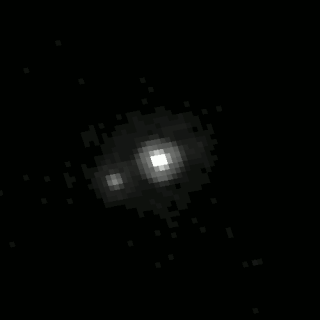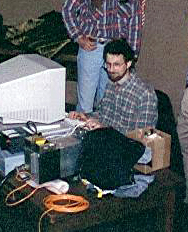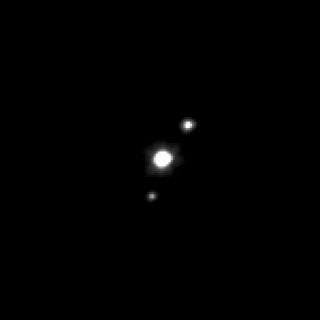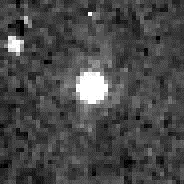
The Two Micron All-Sky Survey, or 2MASS, was an astronomical survey of the whole sky in infrared light. It took place between 1997 and 2001, in two different locations: at the U.S. Fred Lawrence Whipple Observatory on Mount Hopkins, Arizona, and at the Cerro Tololo Inter-American Observatory in Chile, each using a 1.3-meter telescope for the Northern and Southern Hemisphere, respectively. It was conducted in the short-wavelength infrared at three distinct frequency bands near 2 micrometres, from which the photometric survey with its HgCdTe detectors derives its name.

Orcus is a trans-Neptunian dwarf planet with a large moon, Vanth. It has a diameter of 910 km (570 mi). The surface of Orcus is relatively bright with albedo reaching 23 percent, neutral in color and rich in water ice. The ice is predominantly in crystalline form, which may be related to past cryovolcanic activity. Other compounds like methane or ammonia may also be present on its surface. Orcus was discovered by American astronomers Michael Brown, Chad Trujillo, and David Rabinowitz on 17 February 2004.

Chadwick A. Trujillo is an American astronomer, discoverer of minor planets and the co-discoverer of Eris, the most massive dwarf planet known in the Solar System.

Michael E. Brown is an American astronomer, who has been professor of planetary astronomy at the California Institute of Technology (Caltech) since 2003. His team has discovered many trans-Neptunian objects (TNOs), including the dwarf planet Eris, which was originally thought to be bigger than Pluto, triggering a debate on the definition of a planet.

David Lincoln Rabinowitz is an American astronomer, discoverer of minor planets and researcher at Yale University.

Haumea is a dwarf planet located beyond Neptune's orbit. It was discovered in 2004 by a team headed by Mike Brown of Caltech at the Palomar Observatory in the United States and disputably also in 2005 by a team headed by José Luis Ortiz Moreno at the Sierra Nevada Observatory in Spain, though the latter claim has been contested. On September 17, 2008, it was named after Haumea, the Hawaiian goddess of childbirth, under the expectation by the International Astronomical Union (IAU) that it would prove to be a dwarf planet. Nominal estimates make it the third-largest known trans-Neptunian object, after Eris and Pluto, though the uncertainty in best-fit modeling slightly overlaps with the larger size estimates for Makemake.

Makemake is a dwarf planet and the second-largest of what are known as the classical population of Kuiper belt objects, with a diameter approximately 60% that of Pluto. It has one known satellite. Its extremely low average temperature, about 40 K (−230 °C), means its surface is covered with methane, ethane, and possibly nitrogen ices.
(15874) 1996 TL66, provisional designation 1996 TL66, is a trans-Neptunian object of the scattered disc orbiting in the outermost region of the Solar System.
José Luis Ortiz Moreno is a Spanish astronomer, and former Vicedirector of Technology at the Instituto de Astrofísica de Andalucía (IAA), Spain. He leads a team working on minor planets at the Sierra Nevada Observatory in Granada, Spain. The main-belt asteroid 4436 Ortizmoreno was named in his honor.

(55565) 2002 AW197 is a classical, non-resonant trans-Neptunian object from the Kuiper belt in the outermost region of the Solar System, also known as a cubewano. With a likely diameter of at least 700 kilometers (430 miles), it is approximately tied with 2002 MS4 and 2013 FY27 (to within measurement uncertainties) as the largest unnamed object in the Solar System. It was discovered at Palomar Observatory in 2002.

A dwarf planet is a small planetary-mass object that is in direct orbit of the Sun, smaller than any of the eight classical planets but still a world in its own right. The prototypical dwarf planet is Pluto. The interest of dwarf planets to planetary geologists is that they may be geologically active bodies, an expectation that was borne out in 2015 by the Dawn mission to Ceres and the New Horizons mission to Pluto.

Eris is the most massive and second-largest known dwarf planet in the Solar System. It is a trans-Neptunian object (TNO) in the scattered disk and has a high-eccentricity orbit. Eris was discovered in January 2005 by a Palomar Observatory–based team led by Mike Brown and verified later that year. In September 2006, it was named after the Greco–Roman goddess of strife and discord. Eris is the ninth-most massive known object orbiting the Sun and the sixteenth-most massive overall in the Solar System. It is also the largest object that has not been visited by a spacecraft. Eris has been measured at 2,326 ± 12 kilometers (1,445 ± 7 mi) in diameter; its mass is 0.28% that of the Earth and 27% greater than that of Pluto, although Pluto is slightly larger by volume.

(145452) 2005 RN43, also written as (145452) 2005 RN43, is a classical Kuiper belt object. It has an estimated diameter of 679+55
−73 km. It was discovered by Andrew Becker, Andrew Puckett and Jeremy Kubica on 10 September 2005 at Apache Point Observatory in Sunspot, New Mexico. Brown estimates that it is possibly a dwarf planet.
(24835) 1995 SM55, provisional designation 1995 SM55, is a trans-Neptunian object and member of the Haumea family that resides in the Kuiper belt, located in the outermost region of the Solar System. It was discovered on 19 September 1995, by American astronomer Nichole Danzl of the Spacewatch program at Kitt Peak National Observatory near Tucson, Arizona, in the United States. It measures approximately 200 kilometers in diameter and was the second-brightest known object in the Kuiper belt, after Pluto, until 1996 TO66 was discovered.

(145453) 2005 RR43, also written as (145453) 2005 RR43, is a trans-Neptunian object (TNO) estimated to be about 250 km in diameter. It was discovered on 9 September 2005 by Andrew Becker, Andrew Puckett and Jeremy Kubica at Apache Point Observatory in Sunspot, New Mexico.

The outer Solar System planetoid Haumea has two known moons, Hiʻiaka and Namaka, named after Hawaiian goddesses. These small moons were discovered in 2005, from observations of Haumea made at the large telescopes of the W. M. Keck Observatory in Hawaii.

Gonggong (formally 225088 Gonggong; provisional designation 2007 OR10) is a dwarf planet, a member of the scattered disc beyond Neptune. It has a highly eccentric and inclined orbit during which it ranges from 34–101 astronomical units (5.1–15.1 billion kilometers; 3.2–9.4 billion miles) from the Sun. As of 2019, its distance from the Sun is 88 AU (13.2×10^9 km; 8.2×10^9 mi), and it is the sixth-farthest known Solar System object. According to Deep Ecliptic Survey Gonggong is in a 3:10 orbital resonance with Neptune, in which it completes three orbits around the Sun for every ten orbits completed by Neptune. Gonggong was discovered in July 2007 by American astronomers Megan Schwamb, Michael Brown, and David Rabinowitz at the Palomar Observatory, and the discovery was announced in January 2009.

(386723) 2009 YE7, provisional designation 2009 YE7, is a trans-Neptunian object (TNO) discovered by David Rabinowitz on December 17, 2009, at the La Silla Observatory in Chile.


















